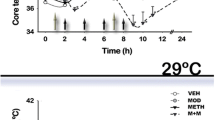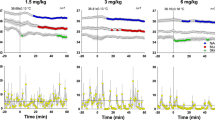Abstract
Rationale
A close relationship appears to exist between 3,4-methylenedioxymethamphetamine (MDMA)-induced changes in core body temperature and long-term serotonin (5-HT) loss.
Objective
We investigated whether changes in core body temperature affect MDMA metabolism.
Materials and methods
Male Wistar rats were treated with MDMA at ambient temperatures of 15, 21.5, or 30°C to prevent or exacerbate MDMA-induced hyperthermia. Plasma concentrations of MDMA and its main metabolites were determined for 6 h. Seven days later, animals were killed and brain indole content was measured.
Results
The administration of MDMA at 15°C blocked the hyperthermic response and long-term 5-HT depletion found in rats treated at 21.5°C. At 15°C, plasma concentrations of MDMA were significantly increased, whereas those of three of its main metabolites were reduced when compared to rats treated at 21.5°C. By contrast, hyperthermia and indole deficits were exacerbated in rats treated at 30°C. Noteworthy, plasma concentrations of MDMA metabolites were greatly enhanced in these animals. Instrastriatal perfusion of MDMA (100 μM for 5 h at 21°C) did not potentiate the long-term depletion of 5-HT after systemic MDMA. Furthermore, interfering in MDMA metabolism using the catechol-O-methyltransferase inhibitor entacapone potentiated the neurotoxicity of MDMA, indicating that metabolites that are substrates for this enzyme may contribute to neurotoxicity.
Conclusions
This is the first report showing a direct relationship between core body temperature and MDMA metabolism. This finding has implications on both the temperature dependence of the mechanism of MDMA neurotoxicity and human use, as hyperthermia is often associated with MDMA use in humans.









Similar content being viewed by others
References
Aguirre N, Barrionuevo M, Ramírez MJ, Del Río J, Lasheras B (1999) α-Lipoic acid prevents 3,4-methylenedioxymethamphetamine (MDMA)-induced neurotoxicity. NeuroReport 10:3675–3680
Bai F, Jones DC, Lau SS, Monks TJ (2001) Serotonergic neurotoxicity of 3,4-(+/−)-methylenedioxyamphetamine and 3,4-(+/−)-methylendioxymethamphetamine (ecstasy) is potentiated by inhibition of gamma-glutamyl transpeptidase. Chem Res Toxicol 14:863–870
Bai F, Lau SS, Monks TJ (1999) Glutathion and N-acetylcysteine conjugates of α-methyldopamine produce serotonergic neurotoxicity: possible role in methylenedioxyamphetamine-mediated neurotoxicity. Chem Res Toxicol 20:1150–1157
Bongiovanni R, Yamamoto BK, Simpson C, Jaskiw GE (2003) Pharmacokinetics of systemically administered tyrosine: a comparison of serum, brain tissue, and in vivo microdialysate levels in the rat. J Neurochem 87:310–317
Breier JM, Bankson MG, Yamamoto BK (2006) l-tyrosine contributes to (+)-3,4-methylenedioxymethamphetamine-induced serotonin depletions. J Neurosci 26:290–299
Broening HW, Bowyer JF, Slikker W Jr (1995) Age-dependent sensitivity of rats to the long-term effects of the serotonergic neurotoxicant (+/−) 3,4-methylenedioxymethamphetamine (MDMA) correlates with the magnitude of the MDMA-induced thermal response. J Pharmacol Exp Ther 275:325–333
Che S, Johnson M, Hanson GR, Gibb JW (1995) Body temperature effect on methylenedioxymethamphetamine-induced acute decrease in tryptophan hydroxylase activity. Eur J Pharmacol 293:447–453
Colado MI, Esteban B, O, Shea E, Granados R, Green AR (1999) Studies on the neuroprotective effect of pentobarbitone on MDMA-induced neurodegeneration. Psychopharmacology 142:421–425
Colado MI, Granados R, O, Shea E, Esteban B, Green AR (1998) Role of hyperthermia in the protective action of clomethiazole against MDMA (‘ecstasy’)-induced neurodegeneration, comparison with the novel NMDA channel blocker AR-R15896AR. Br J Pharmacol 124:479–484
de la Torre R, Farre M (2004) Neurotoxicity of MDMA (ecstasy): the limitations of scaling from animals to humans. Trends Pharmacol Sci 25:505–508
de la Torre R, Farre M, Roset PN, Pizarro N, Abanades S, Segura M, Segura J, Cami J (2004) Human pharmacology of MDMA: pharmacokinetics, metabolism, and disposition. Ther Drug Monit 26:137–144
Easton N, Marsden CA (2006) Ecstasy: are animal data consistent between species and can they translate to humans? J Psychopharmacol 20:194–210
Esteban E, O, Shea E, Camarero J, Sanchez V, Green RA, Colado MI (2001) 3,4-Methylenedioxymethamphetamine induces monoamine release, but not toxicity, when administered centrally at a concentration occurring following a peripherally injected neurotoxic dose. Psychopharmacology 154:251–260
Farfel GM, Seiden LS (1995) Role of hypothermia in the mechanism of protection against serotonergic toxicity. I. Experiments using 3,4-methylenedioxymethamphetamine, dizocilpine, CGS 19755 and NBQX. J Pharmacol Exp Ther 272:860–867
Forsberg MM, Huotari M, Savolainen J, Männistö PT (2005) The role of physicochemical properties of entacapone and tolcapone on their efficacy during local intrastriatal administration. Eur J Pharm Sci 24:503–511
Goni-Allo B, Ramos M, Hervias I, Lasheras B, Aguirre N (2006) Studies on striatal neurotoxicity caused by the 3,4-methylenedioxymethamphetamine/malonate combination: implications for serotonin/dopamine interactions. J Psychopharmacol 20:245–256
Goni-Allo B, Puerta E, Hervias I, Di Palma R, Ramos M, Lasheras B, Aguirre N (2007) Studies on the mechanisms underlying amiloride enhancement of 3,4-methylenedioxymethamphetamine-induced serotonin depletion in rats. Eur J Pharmacol 562:198–207
Green AR, Mechan AO, Elliott JM, O, Shea E, Colado MI (2003) The pharmacology and clinical pharmacology of 3,4-methylenedioxymethamphetamine (MDMA, “ecstasy”). Pharmacol Rev 55:463–508
Green AR, O’shea E, Colado MI (2004) A review of the mechanisms involved in the acute MDMA (ecstasy)-induced hyperthermic response. Eur J Pharmacol 500:3–13
Greene SL, Dargan PI, O, connor N, Jones AL, Kerins M (2003) Multiple toxicity from 3,4-methylenedioxymethamphetamine (“ecstasy”). Am J Emerg Med 21:121–124
Halliwell B (1992) Reactive oxygen species and the central nervous system. J Neurochem 59:1609–1623
Hem A, Smith AJ, Solberg P (1998) Saphenous vein puncture for blood sampling of the mouse, rat, hamster, gerbil, guinea pig, ferret and mink. Lab Anim 32:364–368
Hervias I, Lasheras B, Aguirre N (2000) 2-Deoxy-d-glugose prevents and nicotinamide potentiates 3,4-methylenedioxymethamphetamine-induced serotonin neurotoxicity. J Neurochem 75:982–990
Hiramatsu M, Kumagai Y, Unger SE, Cho AK (1990) Metabolism of methylenedioxymethamphetamine: formation of dihydroxymethamphetamine and quinone identified as its glutathione adduct. J Pharmacol Exp Ther 254:521–528
Johnson EA, O, Callaghan JP, Miller DB (2004) Brain concentrations of d-MDMA are increased after stress. Psychopharmacology 173:278–286
Jones DC, Duvauchelle C, Olsen CM, Lau SS, de la Torre R, Monks TJ (2005) Serotonergic neurotoxic metabolites of ecstasy identified in rat brain. J Pharmacol Exp Ther 313:422–431
Jones DC, Lau SS, Monks TJ (2004) Thioether metabolites of 3,4-methylenedioxyamphetamine and 3,4-methylenedioxymethamphetamine inhibit human serotonin transporter (hSERT) function and simultaneously stimulate dopamine uptake into hSERT-expressing SK-N-MC cells. J Pharmacol Exp Ther 311:298–306
Learmonth DA, Vieira-Coelho MA, Benes J, Alves PC, Borges N, Freitas AP, Soares-da-Silva P (2002) Synthesis of 1-(3,4-dihydroxy-5-nitrophenyl)-2-phenyl-ethanone and derivatives as potent and long-acting peripheral inhibitors of catechol-O-methyltransferase. J Med Chem 45:685–695
Lim HK, Foltz RL (1988) In vivo and in vitro metabolism of 3,4-(methylenedioxy)-methamphetamine in the rat: identification of metabolites using an ion trap detector. Chem Res Toxicol 1:370–378
Malberg JE, Sabol KE, Seiden LS (1996) Co-administration of MDMA with drugs that protect against MDMA neurotoxicity produces different effects on body temperature in the rat. J Pharmacol Exp Ther 278:258–267
Malberg JE, Seiden LS (1998) Small changes in ambient temperature cause large changes in 3,4-methylenedioxymethamphetamine (MDMA)-induced serotonin neurotoxicity and core body temperature in the rat. J Neurosci 18:5086–5094
Mannisto PT, Kaakkola S (1999) Catechol-O-methyltransferase (COMT): biochemistry, molecular biology, pharmacology, and clinical efficacy of the new selective COMT inhibitors. Pharmacol Rev 51:593–628
Miller DB, O’Callaghan JP (2003) Elevated environmental temperature and methamphetamine neurotoxicity. Environ Res 92:48–53
Miller RT, Lau SS, Monks TJ (1997) 2,5-Bis-(glutathion-S-yl)-alpha-methyldopamine, a putative metabolite of (+/-)-3,4-methylenedioxyamphetamine, decreases brain serotonin concentrations. Eur J Pharmacol 323:173–180
Monks TJ, Jones DC, Bai F, Lau SS (2004) The role of metabolism in 3,4-(+)-methylenedioxyamphetamine and 3,4-(+)-methylenedioxymethamphetamine (ecstasy) toxicity. Ther Drug Monit 26:132–136
Morley KC, Li KM, Hunt GE, Mallet PE, McGregor IS (2004) Cannabinoids prevent the acute hyperthermia and partially protect against the 5-HT depleting effects of MDMA (“Ecstasy”) in rats. Neuropharmacology 46:954–965
Nash JF, Yamamoto BK (1992) Methamphetamine neurotoxicity and striatal glutamate release: comparison to 3,4-methylenedioxymethamphetamine. Brain Res 581:237–243
Nixdorf WL, Burrows KB, Gudelsky GA, Yamamoto BK (2001) Enhancement of 3,4-methylenedioxymethamphetamine neurotoxicity by the energy inhibitor malonate. J Neurochem 77:647–654
O’Shea E, Easton N, Fry JR, Green AR, Marsden CA (2002) Protection against 3,4-methylenedioxymethamphetamine-induced neurodegeneration produced by glutathione depletion in rats is mediated by attenuation of hyperthermia. J Neurochem 81:686–695
O’Shea E, Orio L, Escobedo I, Sanchez V, Camarero J, Green AR, Colado MI (2006) MDMA-induced neurotoxicity: long-term effects on 5-HT biosynthesis and the influence of ambient temperature. Br J Pharmacol 148:778–785
Parrott AC (2004) MDMA (3,4-Methylenedioxymethamphetamine) or Ecstasy: the neuropsychobiological implications of taking it at dances and raves. Neuropsychobiology 50:329–335
Patel N, Kumagai Y, Unger SE, Fukuto JM, Cho AK (1991) Transformation of dopamine and α-methyl-dopamine by NG-108–15 cells: Formation of thiol adducts. Chem Res Toxicol 4:421–426
Paxinos G, Watson C (1997) The rat brain in sterotaxic coordinates. Academic, New York
Pizarro N, Ortuno J, Farre M, Hernandez-Lopez C, Pujadas M, Llebaria A, Joglar J, Roset PN, Mas M, Segura J, Cami J, de la Torre R (2002) Determination of MDMA and its metabolites in blood and urine by gas chromatography-mass spectrometry and analysis of enantiomers by capillary electrophoresis. J Anal Toxicol 26:157–165
Quinton MS, Yamamoto BK (2006) Causes and consequences of methamphetamine and MDMA toxicity. AAPS J 8:337–347
Sanchez V, O, Shea E, Saadat KS, Elliott JM, Colado MI, Green AR (2004) Effect of repeated (‘binge’) dosing of MDMA to rats housed at normal and high temperature on neurotoxic damage to cerebral 5-HT and dopamine neurones. J Psychopharmacol 18:412–416
Schmidt CJ, Black CK, Abbate GM, Taylor VL (1990) Methylenedioxymethamphetamine-induced hyperthermia and neurotoxicity are independently mediated by 5-HT2 receptors. Brain Res 529:85–90
Segura M, Ortuno J, Farre M, McLure JA, Pujadas M, Pizarro N, Llebaria A, Joglar J, Roset PN, Segura J, de La Torre R (2001) 3,4-Dihydroxymethamphetamine (HHMA). A major in vivo 3,4-methylenedioxymethamphetamine (MDMA) metabolite in humans. Chem Res Toxicol 14:1203–1208
Shankaran M, Yamamoto BK, Gudelsky GA (2001) Ascorbic acid prevents 3,4-methylenedioxymethamphetamine (MDMA)-induced hydroxyl radical formation and the behavioral and neurochemical consequences of the depletion of brain 5-HT. Synapse 40:55–64
Sprague JE, Banks ML, Cook VJ, Mills EM (2003) Hypothalamic–pituitary–thyroid axis and sympathetic nervous system involvement in hyperthermia induced by 3,4-methylenedioxymethamphetamine (Ecstasy). J Pharmacol Exp Ther 305:159–166
Taraska T, Finnegan KT (1997) Nitric oxide and the neurotoxic effects of methamphetamine and 3,4-methylenedioxymethamphetamine. J Pharmacol Exp Ther 280:941–947
Weir E (2000) Raves: a review of the culture, the drugs and the prevention of harm. CMAJ 162:1843–1848
Yeh SY (1999) N-tert-butyl-alpha-phenylnitrone protects against 3,4-methylenedioxymethamphetamine-induced depletion of serotonin in rats. Synapse 31:169–177
Yuan J, Cord BJ, McCann UD, Callahan BT, Ricaurte GA (2002) Effect of depleting vesicular and cytoplasmic dopamine on methylenedioxymethamphetamine Neurotoxicity. J Neurochem 80:960–969
Zheng Y, Laverty R (1998) Role of brain nitic oxide in (+/−)3,4-methylenedioxymethamphetamine (MDMA)-induced neurotoxicity in rats. Brain Res 795:257–263
Acknowledgment
The authors would like to thank “Fundación para la Investigación Médica Aplicada” (FIMA) and Ministerio de Educación y Ciencia for a fellowship to B.G.-A. and E.P., respectively. This work was supported by grants from the Ministerio de Educación y Ciencia (SAF2005-07919-C02–02), Ministerio de Sanidad y Consumo (PNSD), and the Spanish Networks of Excellence (ISCIII, Red de Trastornos Adictivos, and Red CIEN).
Author information
Authors and Affiliations
Corresponding author
Additional information
Beatriz Goni-Allo and Brian Ó Mathúna contributed equally to this work.
Rights and permissions
About this article
Cite this article
Goni-Allo, B., Ó Mathúna, B., Segura, M. et al. The relationship between core body temperature and 3,4-methylenedioxymethamphetamine metabolism in rats: implications for neurotoxicity. Psychopharmacology 197, 263–278 (2008). https://doi.org/10.1007/s00213-007-1027-1
Received:
Accepted:
Published:
Issue Date:
DOI: https://doi.org/10.1007/s00213-007-1027-1




